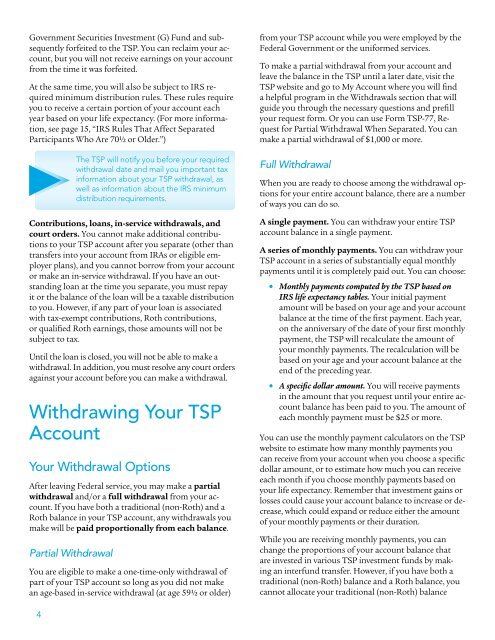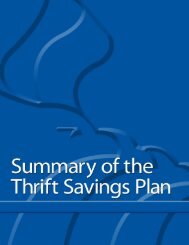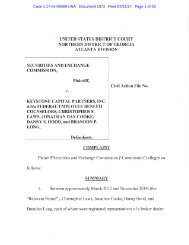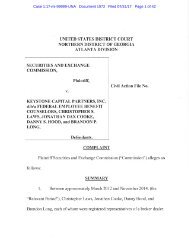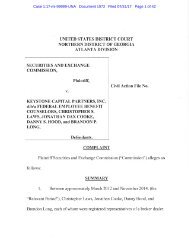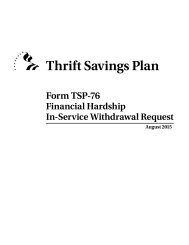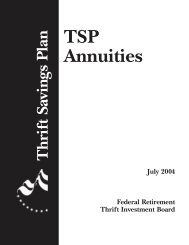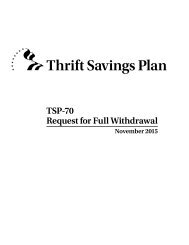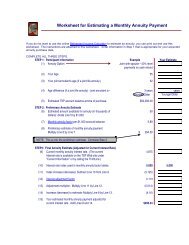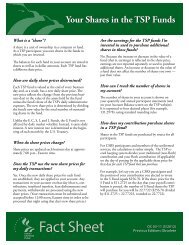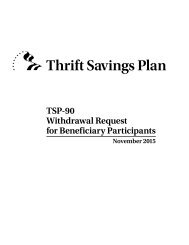Withdrawing Your TSP Account After Federal Service (TSPBK02)
You also want an ePaper? Increase the reach of your titles
YUMPU automatically turns print PDFs into web optimized ePapers that Google loves.
Government Securities Investment (G) Fund and subsequently<br />
forfeited to the <strong>TSP</strong>. You can reclaim your account,<br />
but you will not receive earnings on your account<br />
from the time it was forfeited.<br />
At the same time, you will also be subject to IRS required<br />
minimum distribution rules. These rules require<br />
you to receive a certain portion of your account each<br />
year based on your life expectancy. (For more information,<br />
see page 15, “IRS Rules That Affect Separated<br />
Participants Who Are 70½ or Older.”)<br />
The <strong>TSP</strong> will notify you before your required<br />
withdrawal date and mail you important tax<br />
information about your <strong>TSP</strong> withdrawal, as<br />
well as information about the IRS minimum<br />
distribution requirements.<br />
Contributions, loans, in-service withdrawals, and<br />
court orders. You cannot make additional contributions<br />
to your <strong>TSP</strong> account after you separate (other than<br />
transfers into your account from IRAs or eligible employer<br />
plans), and you cannot borrow from your account<br />
or make an in-service withdrawal. If you have an outstanding<br />
loan at the time you separate, you must repay<br />
it or the balance of the loan will be a taxable distribution<br />
to you. However, if any part of your loan is associated<br />
with tax-exempt contributions, Roth contributions,<br />
or qualified Roth earnings, those amounts will not be<br />
subject to tax.<br />
Until the loan is closed, you will not be able to make a<br />
withdrawal. In addition, you must resolve any court orders<br />
against your account before you can make a withdrawal.<br />
<strong>Withdrawing</strong> <strong>Your</strong> <strong>TSP</strong><br />
<strong>Account</strong><br />
<strong>Your</strong> Withdrawal Options<br />
<strong>After</strong> leaving <strong>Federal</strong> service, you may make a partial<br />
withdrawal and/or a full withdrawal from your account.<br />
If you have both a traditional (non-Roth) and a<br />
Roth balance in your <strong>TSP</strong> account, any withdrawals you<br />
make will be paid proportionally from each balance.<br />
Partial Withdrawal<br />
You are eligible to make a one-time-only withdrawal of<br />
part of your <strong>TSP</strong> account so long as you did not make<br />
an age-based in-service withdrawal (at age 59½ or older)<br />
from your <strong>TSP</strong> account while you were employed by the<br />
<strong>Federal</strong> Government or the uniformed services.<br />
To make a partial withdrawal from your account and<br />
leave the balance in the <strong>TSP</strong> until a later date, visit the<br />
<strong>TSP</strong> website and go to My <strong>Account</strong> where you will find<br />
a helpful program in the Withdrawals section that will<br />
guide you through the necessary questions and prefill<br />
your request form. Or you can use Form <strong>TSP</strong>-77, Request<br />
for Partial Withdrawal When Separated. You can<br />
make a partial withdrawal of $1,000 or more.<br />
Full Withdrawal<br />
When you are ready to choose among the withdrawal options<br />
for your entire account balance, there are a number<br />
of ways you can do so.<br />
A single payment. You can withdraw your entire <strong>TSP</strong><br />
account balance in a single payment.<br />
A series of monthly payments. You can withdraw your<br />
<strong>TSP</strong> account in a series of substantially equal monthly<br />
payments until it is completely paid out. You can choose:<br />
•<br />
•<br />
Monthly payments computed by the <strong>TSP</strong> based on<br />
IRS life expectancy tables. <strong>Your</strong> initial payment<br />
amount will be based on your age and your account<br />
balance at the time of the first payment. Each year,<br />
on the anniversary of the date of your first monthly<br />
payment, the <strong>TSP</strong> will recalculate the amount of<br />
your monthly payments. The recalculation will be<br />
based on your age and your account balance at the<br />
end of the preceding year.<br />
A specific dollar amount. You will receive payments<br />
in the amount that you request until your entire account<br />
balance has been paid to you. The amount of<br />
each monthly payment must be $25 or more.<br />
You can use the monthly payment calculators on the <strong>TSP</strong><br />
website to estimate how many monthly payments you<br />
can receive from your account when you choose a specific<br />
dollar amount, or to estimate how much you can receive<br />
each month if you choose monthly payments based on<br />
your life expectancy. Remember that investment gains or<br />
losses could cause your account balance to increase or decrease,<br />
which could expand or reduce either the amount<br />
of your monthly payments or their duration.<br />
While you are receiving monthly payments, you can<br />
change the proportions of your account balance that<br />
are invested in various <strong>TSP</strong> investment funds by making<br />
an interfund transfer. However, if you have both a<br />
traditional (non-Roth) balance and a Roth balance, you<br />
cannot allocate your traditional (non-Roth) balance<br />
4


